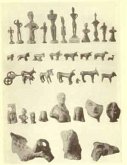Our earliest glimpse of the Aegean area reveals a people in possession of the neolithic culture; as yet they were ignorant of the metals but had learned to polish their stone implements with a view to increasing the cutting power. A good opportunity for the study of progress during the neolithic age is afforded by Cnossus, Crete. The deposits left by the people of this culture on the site of the palace there, measuring in places twenty feet in depth, were doubtless accumulating through several thousand years. During this long age we can trace the slow evolution of mankind by the fragments of pottery which still survive. In the lowest stratum they are of crude clay roughly fashioned by hand. Gradually the potter learned to purify his material, to mould it in somewhat more pleasing forms, and to fire it in an oven. Meanwhile he was making the earliest attempts at ornamentation. The first step was to scratch the surface with angular lines, whence developed the style described as geometric; the next was to fill the incisions with a white chalky substance-the beginning of vase painting. Other varieties of neolithic earthenware need not be considered here...
Dieser Download kann aus rechtlichen Gründen nur mit Rechnungsadresse in A, B, BG, CY, CZ, D, DK, EW, E, FIN, F, GR, H, IRL, I, LT, L, LR, M, NL, PL, P, R, S, SLO, SK ausgeliefert werden.









